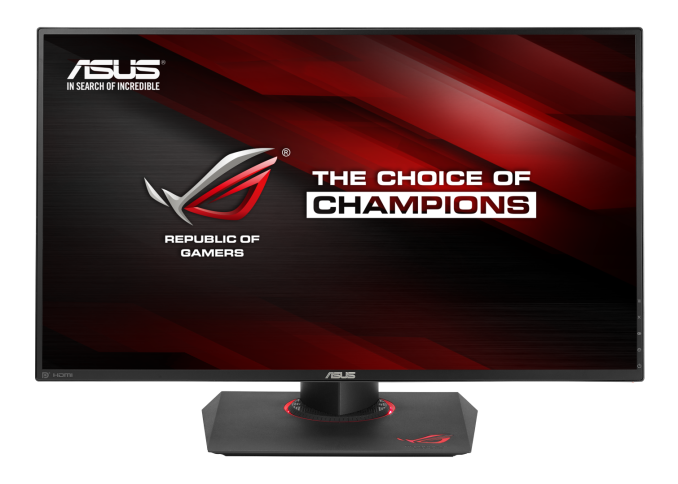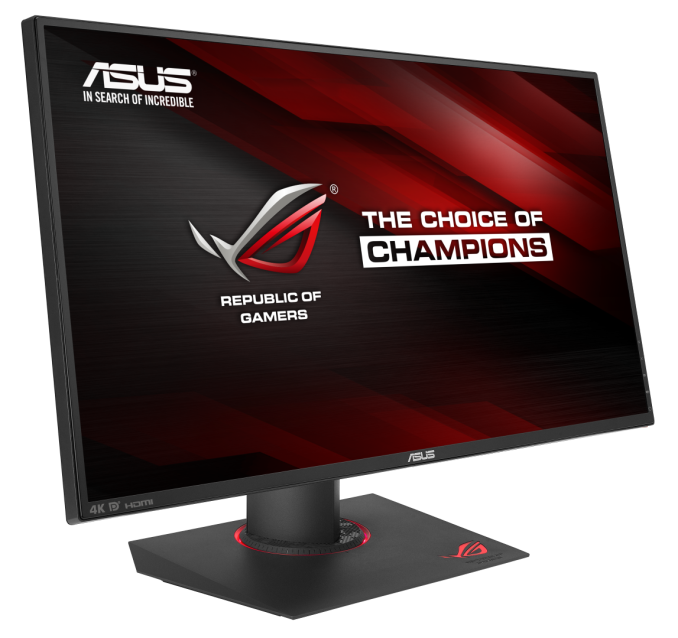ASUS Announces ROG PG279Q & PG27AQ Gaming Monitors
by Brandon Chester on October 9, 2015 6:00 PM EST
Today ASUS announced two new gaming monitors at their Republic of Gamers Unleashed event in San Francisco. Both displays are 27" IPS panels, although there are some significant differences between the two that make each one appeal more or less for certain genres of games. Below you can find all the relevant specifications for both of ASUS's new monitors.
| ASUS PG279Q | ASUS PG27AQ | |
| Resolution | 2560x1440 | 3840x2160 |
| Panel Size | 27" | |
| Panel Type | WLED + IPS | |
| Refresh Rate | 144Hz (OC 165Hz) | 60Hz |
| Contrast Ratio | 1000:1 | |
| Peak Brightness | 350 nits | 300 nits |
| Response Time (GtG) | 4ms | |
| Viewing Angle (H/V) | 178° / 178° | |
| Inputs and Outputs | DisplayPort 1.2 HDMI 1.4 2x USB 3.0 3.5mm audio |
|
| Color Depth | 16.7 million (8bit) | 1.07 billion (10bit) |
| Speakers | 2x 2W Stereo | |
| Other Features | NVIDIA G-Sync NVIDIA Ultra Low Motion Blur |
NVIDIA G-Sync |
| Price | $799 | N/A |
Starting with the PG279Q, we see that it's a 27" WQHD IPS panel with a refresh rate of 144Hz. This monitor is definitely targeted more toward gamers who play games like first person shooters where a high refresh rate is a greater asset than a higher resolution. When paired with a GTX 960 or faster NVIDIA GPU the display's refresh rate can be boosted up to 165Hz, and ASUS has even included a button on the monitor to switch between the two refresh rates on command. This is actually more useful then it sounds, because a user can easily move to 165Hz while gaming, and stick with 144Hz in typical use which will also eliminate telecine judder in 24fps video content.
As for the PG27AQ, I would imagine that gamers who play RTS and simulation games would choose it over the PG279Q for its higher resolution. It's a 27" UHD panel with a refresh rate of 60Hz, and a greater 10bit color depth than the PG279Q's 8bit color. It shares most of the remaining specifications with the PG279Q, including a contrast ratio of 1000:1, a 4ms grey to grey response time, a 178 degree viewing angle on both axis, and the inputs and outputs listed above.
Both of these new monitors feature NVIDIA's G-Sync adaptive refresh rate technology. Even on the PG27AQ this can be useful despite it only being a 60Hz panel, as it will produce a much more fluid image if a game's frame rate drops below 60fps than a non G-Sync / FreeSync display. However, only the PG279Q has NVIDIA's Ultra Low Motion Blur technology which uses a strobing backlight to reduce motion blur. It's worth noting that G-Sync and ULMB are mutually exclusive and you need to choose which one you want a game to use based on whether or not you can maintain the PG279Q's native refresh rate of 144/165Hz.
The ASUS PG279Q will be available in November, with a starting price of $799 in the United States. Pricing and availability for the PG27AQ is currently unknown, but I would imagine that the price will be in the same realm as the PG279Q.











38 Comments
View All Comments
Sogekihei - Sunday, October 11, 2015 - link
144Hz in 3D mode would give 72Hz per eye, allowing you to watch 3D movies without 3:2 pulldown. It took me a while to realize this and I originally thought 144Hz was just an idiotic marketing thing where it was just a bigger number, but thinking this way I can at least believe that there's some logic involved in it.Midwayman - Monday, October 12, 2015 - link
Persistence. If you use ULMB getting into higher refresh rates and lower persistence has a noticeable effect on motion clarity. Granted if you have a mediocre system a lower refresh monitor with adaptive sync is probably better, but there are people who do play games at those frame rates.looper - Sunday, October 11, 2015 - link
These monitors are nice, but I love my Eizo Foris FG2421. I have been gaming since '93, and it's the best gaming monitor I've ever had. http://gaming.eizo.com/products/foris_fg2421/looper - Sunday, October 11, 2015 - link
At Amazon...http://www.amazon.com/FORIS-FG2421-BK-23-5-Inch-Sc...
RussianSensation - Monday, October 12, 2015 - link
I read that this is an awesome monitor but in the last 1.5 years a lot of progress has been made. The Eizo is 1080P, 23.5" which some gamers find too small (myself included) and it has no A-Sync tech of any kind = $620 US per your link. The Asus above has 2560x1440 (win), 27" (win) and G-Sync (win). I think the Eizo is too expensive now relative to what's out there / coming out shortly.In any event, even though I personally have a 2560x1440, I feel like this resolution might never become popular. I think once GPUs get fast enough and prices keep dropping, 4K will take over 1080P and bypass 2560x1440 altogether. Once we have 4K screens with A-Sync at reasonable prices for 28-32" inch sizes, it'll be too hard for 2560x1440P standard to compete. I do feel that 21:9 with 144Hz does have a chance to carve its own niche as it offers something unique.
Aikouka - Sunday, October 11, 2015 - link
Why not have it switch between 120 and 165? I have a ROG Swift monitor, and honestly, I never use it at 144Hz. That may sound really weird, but the reason is that the GPU never drops below 800Mhz because it can't enter a low power state and maintain 144Hz (from what I read). What's the big deal there? According to my UPS, I'm using nearly twice as much power *at idle* (about 120W to 220W or so). It just didn't seem worth it to jump from 120Hz, which can idle, to 144Hz.SeanJ76 - Friday, October 16, 2015 - link
......of course they don't list the most important spec -ppi-alexbagi - Thursday, November 12, 2015 - link
Noticed this site also confirms it as 165Hz: http://www.144hzmonitors.com/monitors/asus-pg279q-...Can you really feel a difference between 144Hz and 165Hz though?